In: women
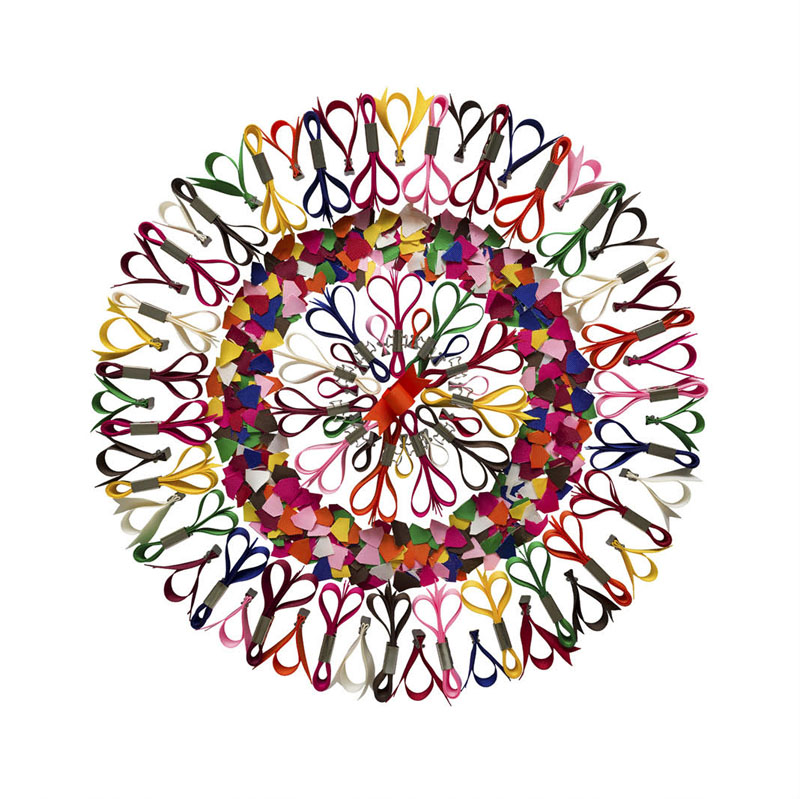
Leslie Hossack | Ribbon of Tears No. 8
December 13, 2021Leslie Hossack | No. 8
Leslie Hossack is an Ottawa photographer who created this image as part of a series of 11 pieces reflecting on the devastation of residential schools.
Hossack describes these works as follows:
“These photographs are my response to the ongoing tragedy of Canadian residential schools. The compositions were inspired by memories of my own childhood – ribbons, crayons, kaleidoscopes, pinwheels. I felt cared-for and carefree. That is what I wish for every child.
I hope these images will provide a starting point for conversations about the history and legacy of residential schools – conversations building towards truth and reconciliation. Ribbon of Tears is dedicated to all those robbed of their childhood by residential schools.”
Artist’s Note: These photographs are not for sale commercially. However, prints can be ordered directly through Toronto Image Works at a cost of 30% off the list price.
More images by this artist can be enjoyed at her Instagram account here and at her website ~ Peppa Martin
Read More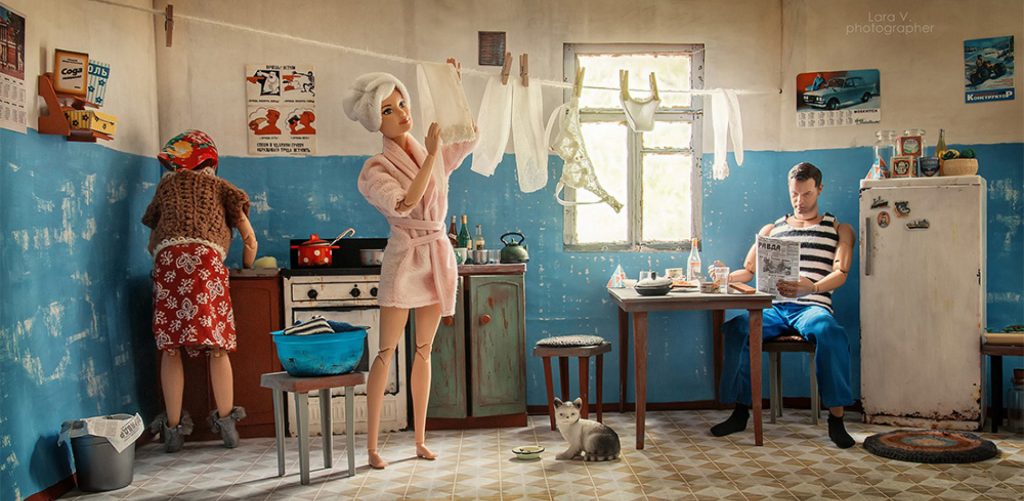
Lara Vychuzhanina | The life of Barbie and Ken in the Soviet Union
November 30, 2021Lara Vychuzhanina | The life of Barbie and Ken in the Soviet Union, 2017
First as tragedy, then as farce, we were warned a long time ago by Marx, is how history will play out. That’s a bit damning, but as we make our way further into the 21st century, it’s to be forgiven if many of us also see a more black than bleak humour in all this, a dark comedy that still makes us laugh, inappropriately.
Lara Vychuzhanina (whose Instagram name is aptly @lara_art_dolls) is a Russian photographer from Yekaterinburg – formerly known as Sverdlovsk, during the Soviet era, which I mention as it intersects with some of the ideas present in her work here, where she’s created a tableaux of Barbie and her partner Ken living in the USSR in the 1980s.
There’s always an element of nostalgia in depictions of history, allusions to a ‘simpler time’, and it’s interesting to see one about the USSR, as in the West we’re usually inundated with this false trope about the 1950s, or 1960s: Lara Vychuzhanina is too young to remember the 1980s in the former Soviet Union, but this doesn’t stop others from offering caustic and contested interpretations of those eras, either. Employing Barbie and Ken for this is a nice intersection of mythologies of East and West, capitalism and communism, plasticity and reality – and it is also, in the inherent contradictions of its assemblage, very funny.
After all, “comedy is in act superior to tragedy and humourous reasoning superior to grandiloquent reasoning” (which, fittingly, is attributed to Friedrich Engels by Karl Marx, back in 1862)…..
More images by this artist can be enjoyed at her Instagram. ~ Bart Gazzola
Read More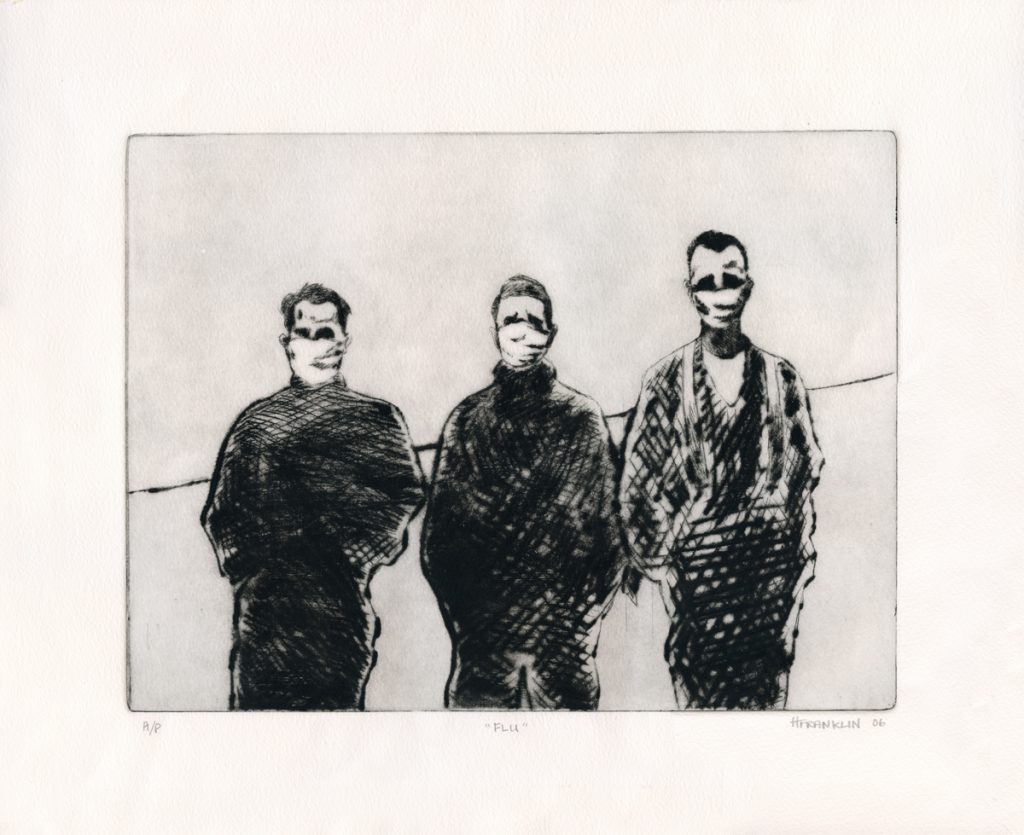
Heather Franklin | Flu
November 22, 2021Context is everything.
I first saw Flu, by Heather Franklin, in 2010. Heather, the Director of The Button Factory, Waterloo Ontario’s Community Arts Centre, made this drypoint print in 2006, drawn from a photo of three men during the Spanish Flu epidemic in 1918.
What drew me to the image was its strangeness. Three men, obviously out of doors (as indicated by the skewed horizon line, so likely to be farmers), in masks, facing an invisible, deadly threat. The title gave away the timeline and narrowed the reason for their masked anonymity to a necessity rather than a choice – they were not running from the law. But the masks still made them “others”, unrecognizable, in a situation I could not fathom. The print carried with it a sense of the uncanny, with a deep sense of foreboding.
In 2021, these men have become very knowable. They are us. They are simple people, dealing with a situation beyond their control in the simplest way they can. Now I find myself less concerned with the contagion swirling around them than with the economic straits they find themselves in, how their families are coping, whether or not they have lost loved ones. They have become human where once they were alien.
You can find more of Heather’s fine illustrations on her Instagram account @heathersphotophoto.
~ Mark Walton
Read More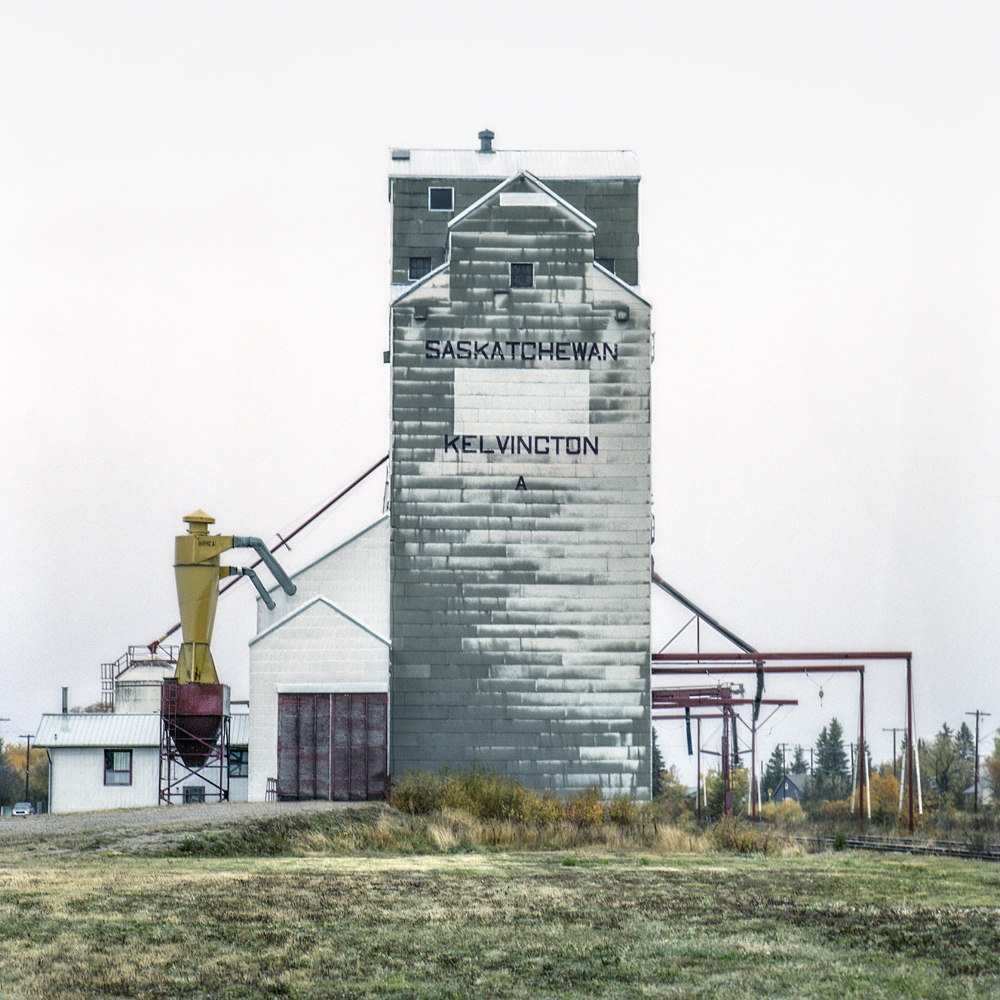
Discovering Self: The Photography of Vera Saltzman
January 4, 2022Discovering Self The Photography of Vera Saltzman Grain Elevator No. 18 This article originally featured in the TYPOLOGIES edition of photoED... Read More

Les Femmes Photographes De La nouvelle Vision En France 1920-1940 | Christian Bouqueret, 1998
January 13, 2022Les Femmes Photographes
De La nouvelle Vision En France 1920-1940 | Christian Bouqueret, 1998
Nicéphore Niépce Museum (Chalon-sur-Saône, Saône-et-Loire); Museum of Art, History and Archeology (Evreux); French Mission of photographic heritage; French association for the dissemination of photographic heritage.
This is the accompanying text to the exhibition Women photographers of the new vision in France, 1920-1940, which was on display in numerous places in France, including Paris (Hôtel de Sully, April 3-June 7, 1998), Chalon-sur-Saône (Musée Nicéphore Niépce, June 19-September 13, 1998) and Evreux, Musée of the old Bishop’s Palace, October-November 1998).
The artists in this show and the book are an impressive group of photographers whose works are still groundbreaking and evocative, almost a century later. These include Berenice Abbott, Laure Guillot, Denise Bellon, Ilse Bing, Germaine Krull, Dora Maar, Lee Miller, Claude Cahun, Lisette Model, Marianne Breslauer, Yvonne Chevalier, Nora Dumas, Gertrude Fehr, Gisèle Freund, Florence Henri, Annelise Kretschmer, Ergy Landau, Juliette Lasserre, Thérèse Le Prat, Dora Kallmus / Madame d’Ora, Rogi André, Ré Soupault, Gerda Taro and Camilla “Ylla” Koffler.
Bouqueret’s writing is in French, but the images are – of course – the real joy of this book. After reading it, I spent endless hours online, looking for more works by these artists. Research is too formal a word, as these photographs pulled me into a different time, and it was a way, again, in which the availability of artists’ works online is a treasure.
In light of that, I must also recommend this site: AWARE (Archive of Women Artists, Research and Exhibitions), as they have many images and information about the artists featured by Bouqueret, and much more.
It can be ordered online here, though I acquired a copy through my local library. ~ Bart Gazzola
Read More
The Quilts of Gee’s Bend: Masterpieces from a Lost Place
November 5, 2021The Quilts of Gee’s Bend: Masterpieces from a Lost Place, 2002
Essays by John Beardsley, William Arnett, Paul Arnett and Jane Livingston, with an introduction by Alvia Wardlaw and a foreword by Peter Marzio (Tinwood Books, Atlanta in association with the Museum of Fine Arts, Houston)
In a conversation recently with a group of artists in Niagara-on-the-Lake, a question was raised about what is a dominant trend in the art world. I always find these kind of questions amusing – not in a derogatory way – as there are so many respective groups within even the Canadian art milieu that are often unaware of each other, or don’t acknowledge each other, that any singular dominant trend is an impossibility. Oftentimes, there are pockets of artists creating work that merit far more attention from other audiences, but that also seem quite happy to be making artworks for themselves, and larger recognition – or fame – will come to them, in time, if they even want these things.
The artists of Gee’s Bend are part of a unique community in the United States (more can be learned about them here). From the aforementioned link : “Throughout this time, and up until the present, the settlement’s unique patchwork quilting tradition that began in the 19th century has endured. Hailed by the New York Times as “some of the most miraculous works of modern art America has produced,” Gee’s Bend quilts constitute a crucial chapter in the history of American art and today are in the permanent collections of over 20 leading art museums.”
“At first glance, the quilts of this collection are simply stunning–rich colors in surprising combinations, refreshingly irregular geometric compositions with hardly a right angle among them, big blocks whose seams virtually vibrate with energy. Then consider the history of the community they come from, and these quilts become a stunning illustration of resourcefulness. Gee’s Bend, a remote peninsula on the Alabama River, is an isolated place, one that has known extreme poverty and struggle. Its quilters of the twentieth century are showcased here. Three insightful essays on the community’s history and its quilting tradition make up for a self-consciously scholarly introduction. The words of the quilters themselves follow. Brief accounts of their lives and thoughts on quilting accompany full-page photographs of their accomplishments. This large-format hardcover, and coinciding exhibition at the Whitney Museum of American Art, should guarantee the women of Gee’s Bend the prominence they deserve in the story of the American quilt.” (Marya Graff)
This book offers many beautiful images of the quilts, and a number of essays about the artists and their place in the history American art, positioning the quilts as work by amazing artists who are as impressive as any of their contemporaries that were showing in New York and being lauded by critics and curators.
Seek this out in your library, or your locally owned bookstore – and there’s a fine Instagram account that highlights Gee’s Bend artists, past and present, here.
~ Bart Gazzola
Read More
Diana Nicholette Jeon
November 11, 2021Diana Nicholette Jeon is a Hawai’i based photographer whose works have been widely published and exhibited, including (coincidentally) by The COVERT Collective’s Peppa Martin. Diana’s photos have won awards at the Julia Margaret Cameron Awards, the Moscow Foto Awards and the Pollux Awards to name a few.
“Untitled (from the series, 860 Days)” is a photo that immediately conveys a sense of solitude. The extreme blurring of part of the image takes it a step further to impart an unwanted sense of loneliness, and of not knowing how to escape it… like a bad dream. In fact, the series itself (here) is “about my experience of loss, isolation, anguish and loneliness during a marital separation.”
Jeon’s other projects are equally as personal and introspective, and often combine selfies with other photographic elements to create unique pastiches that engage the viewer to try to connect with the psyche of Jeon herself… what is she feeling here? … why did she choose this? While all art seeks to create this bond with its audience, Jeon’s work is extraordinarily successful at it.
You can see more of Diana’s work at her website, including the series Self-Exposure, Socially Speaking, Nights as Inexorable as the Sea and I, Orfeo.
https://diananicholettejeon.com/
~ Mark Walton
Read More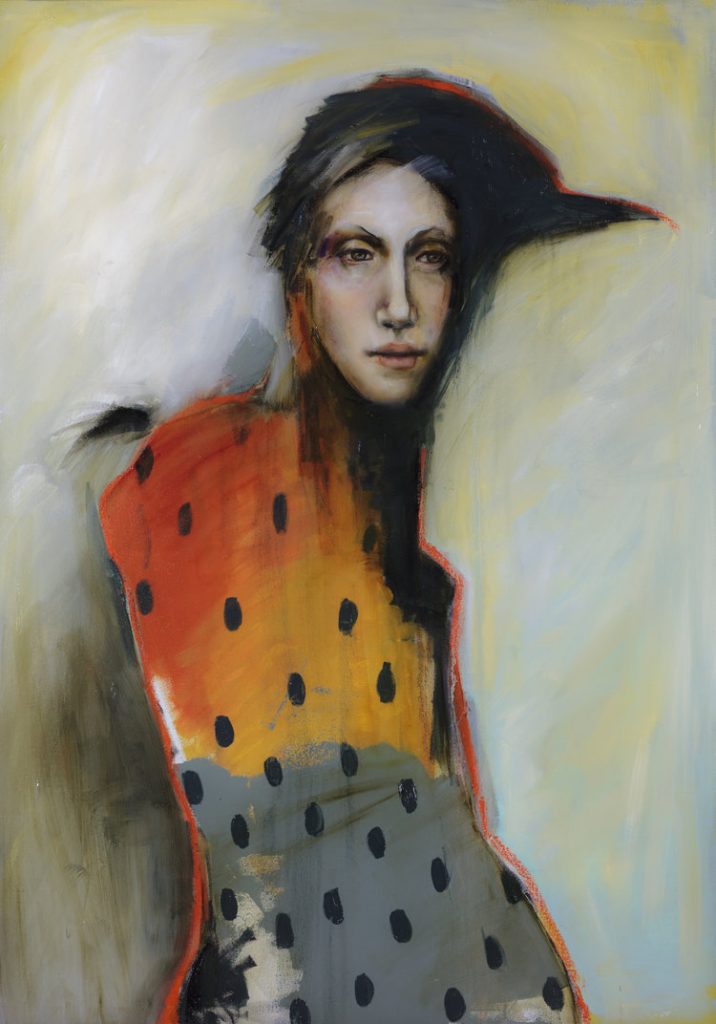
Michele Mikesell
October 31, 2021The Morrigan, 2017 by Michele Mikesell
Michele Mikesell’s characters peer back at you. Often, they seem to look through you. This is understandable as her inspiration is so often taken from mythology, with figures like this one (or ones, considering that the Morrigan is sometimes a trio, all sisters, called the three Morrígna) that embody larger ideas that dwarf the individual viewer. The imaginary portrait that Mikesell offers here is titled The Morrigan (but she / they are also called Mórrígan, sometimes named Morrígu, a powerful deity from Irish mythology. In Modern Irish she is Mór-Ríoghain, meaning “great queen” or “phantom queen”). A divinity of war and fate, often a harbinger who foretells doom, death or victory in battle, she’s often been depicted – as alluded to in the shadows here – as a crow (birds which still unsettle us as dark omens, or as scavengers of carrion, perhaps those who fall in battle….perhaps a psychopomp, even, waiting to escort the newly dead to their just reward…).
She looks fittingly unimpressed. (“It is better to fall in with crows than with flatterers; for in the one case you are devoured when dead, in the other case while alive.” – Antisthenes / Ἀντισθένης, c. 445 – c. 365 BC)
There’s a sense of whimsy to many of Mikesell’s anthropomorphic figures, blending animal and human, often titled for old gods like Artemis or Bastet. Another painting is titled Huginn, one of Odin’s ravens – another foreboding bird, knowing and seeing much. She lives in Dallas, Texas and Spain, and “her paintings hone in on the connectedness between human ideas and animal instinct. Irony, contradiction, humor and tragedy are themes throughout her work.”
Many more of her fine paintings (as it was very difficult to select just one) can be enjoyed here. ~ Bart Gazzola
Read More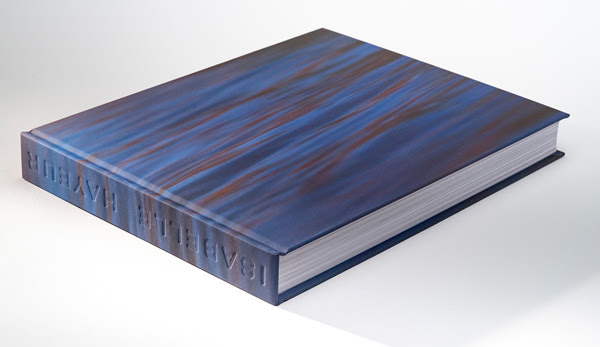
ISABELLE HAYEUR: Monograph
November 2, 2021ISABELLE HAYEUR: Monograph
By Mona Hakim, Peggy Gale, & Ann Thomas
Hardcover, 2020, 360 pages, available from Les éditions Plein sud
Texts in French and English $70 + Shipping
Committed to environmental causes since the 1990s, Isabelle Hayeur takes an acute critical look at the changes in our ecosystems caused by the devastating impacts of massive urbanization and industrialization on our territories.
This monograph, the most exhaustive publication to date on this artist’s work, leads us to the heart of her creative activity. Bringing together numerous visual documents, from her composite photo-graphs to portraits of citizen gatherings and activist groups by way of videos, installations in public spaces, and reflective texts, this richly illustrated book explores the vast production of an artist who has gained recognition in the contemporary art world, in Quebec and internationally. The texts present the reader with enlightened insights into the artist’s various accomplishments.
Read more about this monograph and order it here.
This recommendation appeared in the Fall 2021 – ECO ISSUE of PhotoED Magazine. If you’re looking for more Canadian photography inspiration check out PhotoED Magazine, in print + online https://www.photoed.ca
~ Rita Godlevskis
Read More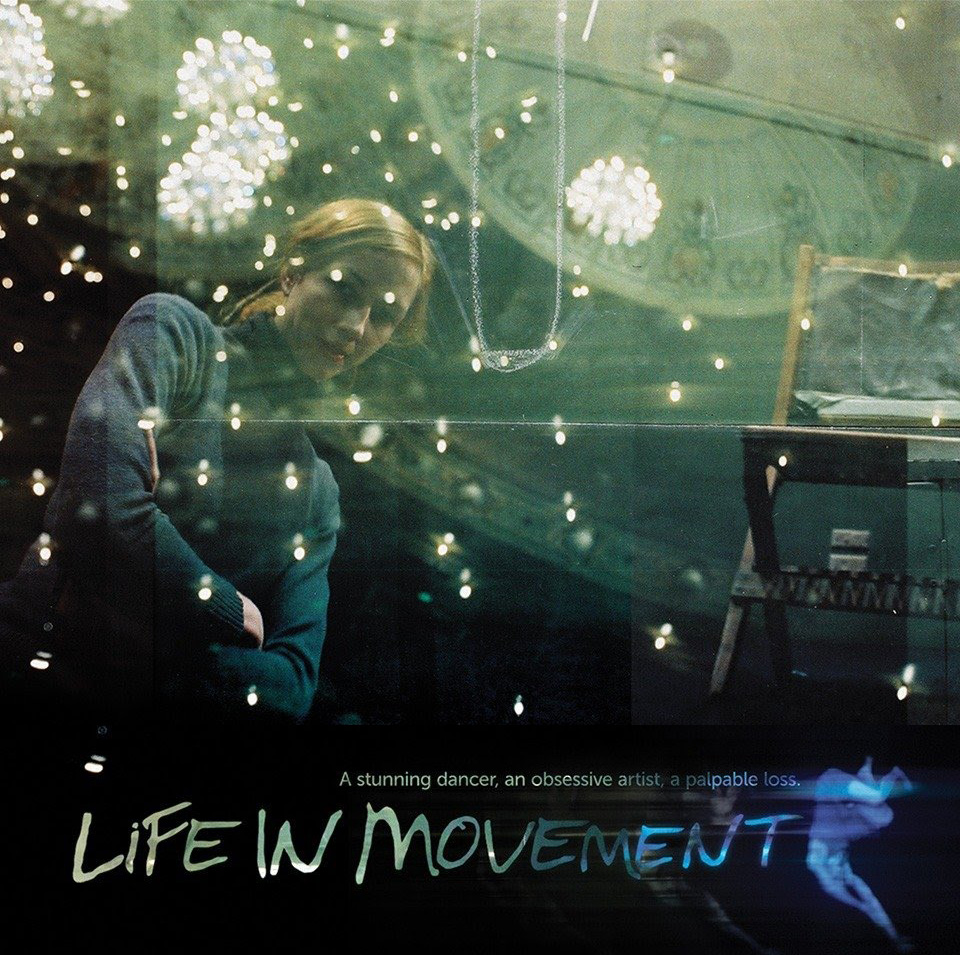
Life In Movement – The Tanya Liedtke story
November 8, 2021Life In Movement
2011
Closer Productions
I have 3 ½ left feet. As a sometimes musician I have a great sense of rhythm, but it has never been able to translate into my limbs. As a pre-teen and adolescent, I never knew anyone taking dance classes, never attended any recitals or ballets or other artistic events involving dance… in short, I am the last person you might think who would offer up Closer Productions’ Life In Movement as a documentary film that made such a difference in my artistic practice.
The multi-award-winning film focuses on Tanja Liedtke, the late choreographer of the Sydney Dance Company, who was killed at age 29 before she could take her position. A lauded professional dancer, Life in Movement documents Liedtke’s intentional cultivation of a creative life and her near obsessive process. The dance sequences she created seem to defy physics; she would push her dancers to their breaking points yet pushed herself even further.
Watching the film made me question my own motives as an artist. Liedtke was “all-in” to an extent that I could not emulate as a musician. My passion for photography was/is a completely different animal, and I poured everything I had into it. Life in Movement helped me to focus my intent and my path forward.
The documentary will bring joy, sadness, admiration and reflection to any artist who watches. It is NOT available for streaming in Canada but you can purchase a copy from the Closer Productions website. ~ Mark Walton
Read More
Recent Comments